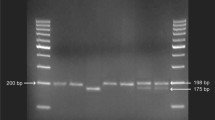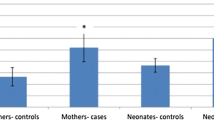Abstract
Background and Objective
Oxidative stress is one of the pathophysiological factors of pPROM and Vit. E being antioxidant may have preventive role. Study was conducted to estimate maternal serum vitamin E levels and cord blood oxidative stress markers in pPROM cases.
Methods
This was a case–control study including 40 pPROM cases and 40 controls. Maternal serum vitamin E levels were measured at recruitment. Cord blood was collected at delivery for estimation of telomere length and mtDNA copy number as oxidative stress markers. Levels were compared using student’s t test or Mann Whitney test. For correlation Pearson coefficient was used.
Results
Maternal serum vitamin E levels were normal in pPROM cases. Cord blood telomere length was more in pPROM than controls (428.99 ± 290.65 vs 322.35 ± 180.33) (p value 0.05). Cord blood mtDNA copy number was more in pPROM than controls (516.46 ± 443.55 vs 384.77 ± 328.27) (p value 0.13) though it was not significant. mtDNA copy number had negative correlation with Vit. E levels but it was statistically not significant (p value 0.49). There was no association of vitamin E levels with telomere length (p value 0.95).
Interpretation and Conclusion
pPROM was not associated with vitamin E deficiency. There was insignificant oxidative stress in cord blood as measured by mtDNA copy number but cord blood telomere length measurement did not detect any oxidative stress in pPPROM cases.


Similar content being viewed by others
References
Goldenberg RL, Culhane JF, Iams JD, Romero R. Epidemiology and causes of preterm birth. Lancet. 2008;371(9606):75–84.
Plessinger MA, Woods JR Jr, Miller RK. Pretreatment of human amnion-chorion with vitamins C and E prevents hypochlorous acid-induced damage. Am J Obstet Gynecol. 2000;183(4):979–85.
Woods JR Jr, Plessinger MA, Miller RK. Vitamins C and E: missing links in preventing preterm premature rupture of membranes? Am J Obstet Gynecol. 2001;185(1):5–10.
Spinnato JA, Freire S, Pinto e Silva JL, Rudge MV, Martins-Costa S, Koch MA, et al. Antioxidant supplementation and premature rupture of the membranes: a planned secondary analysis. Am J Obstet Gynecol. 2008;199(4):433e1-8.
Gungorduk K, Asicioglu O, Gungorduk OC, Yildirim G, Besimoğlu B, Ark C. Does vitamin C and vitamin E supplementation prolong the latency period before delivery following the preterm premature rupture of membranes? a randomized controlled study. Am J Perinatol. 2014;31(3):195–202.
Rumbold A, Ota E, Hori H, Miyazaki C. Crowther CA (2015) Vitamin E supplementation in pregnancy. Cochrane Database Syst Rev. 2015;9:CD004069. https://doi.org/10.1002/14651858.CD004069.pub3.
Kacerovsky M, Tothova L, Menon R, Vlkova B, Musilova I, Hornychova H, et al. Amniotic fluid markers of oxidative stress in pregnancies complicated by preterm prelabor rupture of membranes. J Matern Fetal Neonatal Med. 2015;28(11):1250–9.
Harley CB, Futcher AB, Greider CW. Telomeres shorten during ageing of human fibroblasts. Nature. 1990;345(6274):458–60.
Houben JM, Moonen HJ, van Schooten FJ, Hageman GJ. Telomere length assessment: biomarker of chronic oxidative stress? Free Radic Biol Med. 2008;44(3):235–46.
Friedrich U, Schwab M, Griese EU, Fritz P, Klotz U. Telomeres in Neonates: new insights in Fetal hematopoiesis. Pediatr Res. 2001;49:252–6.
Zglinicki T. Oxidative stress shortens telomeres. Trends Biochem Sci. 2002;27:339–44.
Menon R, Yu J, Basanta-Henry P, Brou L, Berga SL, Fortunato SJ, Taylor RN. Short fetal leukocyte telomere length and preterm prelabor rupture of the membranes. PLoS ONE. 2012;7(2):e31136.
Carelli V, Maresca A, Caporali L, Trifunov S, Zanna C, Rugolo M. Mitochondria: Biogenesis and mitophagy balance in segregation and clonal expansion of mitochondrial DNA mutations. Int J Biochem Cell Biol. 2015;63:21–4.
Meyer JN, Hartman JH, Mello DF. Mitochondrial toxicity. Toxicol Sci. 2018;162(1):15–23.
Zhong J, Cayir A, Trevisi L, Sanchez-Guerra M, Lin X, Peng C, et al. Traffic-Related air pollution, blood pressure, and adaptive response of Mitochondrial abundance. Circulation. 2016;133(4):378–87.
Suhail M, Patil S, Khan S, Siddiqui S. Antioxidant vitamins and lipoperoxidation in non-pregnant, pregnant, and gestational diabetic women: erythrocytes osmotic fragility profiles. J Clin Med Res. 2010;2(6):266–73.
Cawthon RM. Telomere length measurement by a novel monochrome multiplex quantitative PCR method. Nucleic Acids Res. 2009;37(3):e21.
Menon R, Richardson LS. Preterm prelabor rupture of the membranes: a disease of the fetal membranes. Semin Perinatol. 2017;41(7):409–19.
Longini M, Perrone S, Vezzosi P, Marzocchi B, Kenanidis A, Centini G, et al. Association between oxidative stress in pregnancy and preterm premature rupture of membranes. Clin Biochem. 2007;40(11):793–7.
Mathews F, Neil A. Antioxidants and preterm prelabour rupture of the membranes. BJOG. 2005;112(5):588–94.
Lin C, Yang D. Human Telomeric G-Quadruplex structures and G-Quadruplex-interactive compounds. Methods Mol Biol. 2017;1587:171–96.
Hayflick L. Mortality and immortality at the cellular level. A review Biochemistry (Mosc). 1997;62(11):1180–90.
Ferrari F, Facchinetti F, Saade G, Menon R. Placental telomere shortening in stillbirth: A sign of premature senescence? J Matern Fetal Neonatal Med. 2016;29(8):1283–8.
Menon R. Oxidative stress damage as a detrimental factor in preterm birth pathology. Front Immunol. 2014;5:567.
Sanchez-Guerra M, Peng C, Trevisi L, Cardenas A, Wilson A, Osorio-Yáñez C, et al. Altered cord blood mitochondrial DNA content and pregnancy lead exposure in the progress cohort. Environ Int. 2019;125:437–44.
Funding
No funding was received for the study.
Author information
Authors and Affiliations
Contributions
All authors contributed to the study conception and design. Material preparation, data collection and analysis were performed by Dr RK, Dr A S and Dr MM. The first draft of the manuscript was written by Dr RK, Dr RM and Dr AS. All authors commented on previous versions of the manuscript. All authors read and approved the final manuscript.
Corresponding author
Ethics declarations
Conflict of interest
The authors declare that they have no potential conflict of interest.
Ethical Approval
The study was approved by the Institutional Ethical Committee—Human Research of University College of Medical Sciences and GTB Hospital, Delhi. The study was performed in accordance with the ethical standards as laid down in the 1964 Declaration of Helsinki and its later amendments.
Informed Consent
Written voluntary informed consent to participate in the study was obtained from all the participants.
Additional information
Publisher's Note
Springer Nature remains neutral with regard to jurisdictional claims in published maps and institutional affiliations.
Rupa Kumari (MD), Senior Resident, Department of Obstetrics and Gynecology, University College of Medical Sciences and Guru Teg Bahadur Hospital, Delhi, India; Amita Suneja (MD), Director Professor and Head, Department of Obstetrics and Gynecology, University College of Medical Sciences and Guru Teg Bahadur Hospital, Delhi, India; Mohit Mehndiratta, Associate Professor, Department of Biochemistry, University College of Medical Sciences and Guru Teg Bahadur Hospital, Delhi, India; Kiran Guleria (MD), Director Professor, Department of Obstetrics and Gynecology, University College of Medical Sciences and Guru Teg Bahadur Hospital, Delhi, India; Rashmi Malik, Associate Professor, Department of Obstetrics and Gynecology, University College of Medical Sciences and Guru Teg Bahadur Hospital, Delhi, India.
Rights and permissions
About this article
Cite this article
Kumari, R., Suneja, A., Mehndiratta, M. et al. Maternal Serum Vitamin E Levels and its Association with Cord Blood Telomere Length and Mitochondrial DNA Copy Number in Preterm Premature Rupture of Membranes. J Obstet Gynecol India 73, 9–14 (2023). https://doi.org/10.1007/s13224-022-01684-1
Received:
Accepted:
Published:
Issue Date:
DOI: https://doi.org/10.1007/s13224-022-01684-1




